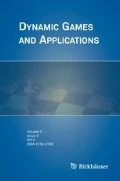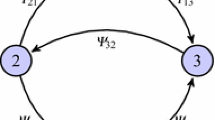Abstract
We provide an overview of recent research on belief and opinion dynamics in social networks. We discuss both Bayesian and non-Bayesian models of social learning and focus on the implications of the form of learning (e.g., Bayesian vs. non-Bayesian), the sources of information (e.g., observation vs. communication), and the structure of social networks in which individuals are situated on three key questions: (1) whether social learning will lead to consensus, i.e., to agreement among individuals starting with different views; (2) whether social learning will effectively aggregate dispersed information and thus weed out incorrect beliefs; (3) whether media sources, prominent agents, politicians and the state will be able to manipulate beliefs and spread misinformation in a society.
Similar content being viewed by others
References
Acemoglu D, Ozdaglar A, ParandehGheibi A (2010) Spread of (mis)information in social networks. Games Econ Behav, forthcoming
Acemoglu D, Como G, Fagnani F, Ozdaglar A (2010) Persistent disagreement in social networks. Working paper
Acemoglu D, Bimpikis K, Ozdaglar A (2010) Communication information dynamics in (endogeneous) networks. LIDS report 2813, working paper
Acemoglu D, Dahleh M, Lobel I, Ozdaglar A (2010) Heterogeneity and social learning. Working paper
Acemoglu D, Dahleh M, Lobel I, Ozdaglar A (2009) Bayesian learning in social networks. LIDS report 2780
Acemoglu D, Chernozhukov V, Yildiz M (2007) Learning and disagreement in an uncertain world. Working paper
Aldous D, Fill J (2002) Reversible Markov chains and random walks on graphs. Monograph in preparation. http://www.stat.berkeley.edu/aldous/RWG/book.html
Allen B (1981) Generic existence of completely revealing equilibria for economies with uncertainty when prices convey information. Econometrica 49(5):1173–1199
Deffuant G, Amblard F, Weisbuch G, Faure T (2002) How can extremism prevail? A study based on the relative agreement interaction model. J Artif Soc Soc Simul 5(4)
Bala V, Goyal S (1998) Learning from neighbours. Rev Econ Stud 65(3):595–621
Banerjee A (1992) A simple model of herd behavior. Q J Econ 107:797–817
Banerjee A, Fudenberg D (2004) Word-of-mouth learning. Games Econ Behav 46:1–22
Bikhchandani S, Hirshleifer D, Welch I (1992) A theory of fads, fashion, custom, and cultural change as information cascades. J Polit Econ 100:992–1026
Binmore K (2008) Rational decisions. Princeton University Press, Princeton
Bisin A, Verdier T (2001) The economics of cultural transmission and the dynamics of preferences. J Econ Theory 97(2):298–319
Bisin A, Verdier T (2000) Beyond the melting pot: cultural transmission, marriage, and the evolution of ethnic and religious traits. Q J Econ 115(3):955–988
Blondel VD, Hendrickx JM, Tsitsiklis JN (2009) On Krause’s multi-agent consensus model with state-dependent connectivity. IEEE Trans Autom Control 54(11):2586–2597
Boyd S, Ghosh A, Prabhakar B, Shah D (2005) Gossip algorithms: design, analysis, and applications. In: Proceedings of IEEE INFOCOM
Boyd R, Richerson PJ (1985) Culture and the evolutionary process. The University of Chicago Press, Chicago
Cavalli-Sforza LL, Feldman MW (1981) Cultural transmission and evolution: a quantitative approach. Princeton University Press, Princeton
Chamley C, Gale D (1994) Information revelation and strategic delay in a model of investment. Econometrica 62:1065–1086
Chen Y, Kartik N, Sobel J (2008) Selecting cheap talk equilibria. Econometrica 76(1):117–136
Clifford P, Sudbury A (1973) A model for spatial conflict. Biometrika 60:581–588
de Condorcet NC (1785) Essai sur l’application de l’analyse à la probabilite des décisions rendues à la pluralite des voix. Imprimerie Royale, Paris
Crawford V, Sobel J (1982) Strategic information transmission. Econometrica 50(6):1431–1451
Cripps M, Ely J, Mailath G, Samuelson L (2008) Common learning. Econometrica 76:909–933
Deffuant G, Neau D, Amblard F, Weisbuch G (2000) Mixing beliefs among interacting agents. Adv Complex Syst 3:87–98
DeGroot MH, Reaching a consensus. J Am Stat Assoc 69:118–121
DellaVigna S, Kaplan E (2007) The Fox News effect: media bias and voting. Q J Econ 122:1187–1234
DeMarzo PM, Vayanos D, Zwiebel J (2003) Persuasion bias, social influence, and unidimensional opinions. Q J Econ 118(3):909–968
Ellison G, Fudenberg D (1993) Rules of thumb for social learning. J Polit Econ 101(4):612–643
Ellison G, Fudenberg D (1995) Word-of-mouth communication and social learning. Q J Econ 110:93–126
Fagnani F, Zampieri S (2008) Randomized consensus algorithms over large scale networks. IEEE J Sel Areas Commun, forthcoming
Farrell J, Rabin M (1996) Cheap talk. J Econ Perspect 10(3):103–118
Fortunato S, Stauffer D (2006) Computer simulations of opinions and their reactions to extreme events. In: Albeverio S, Jentsch V, Kantz H (eds) Extreme events in nature and society, 2005. Springer, Berlin
Foster D, Vohra RV (1997) Calibrated learning and correlated equilibrium. Games Econ Behav 21:40–55
Foster D, Vohra RV (1999) Regret in the online decision problem. Games Econ Behav 29:7–35
Fudenberg D, Levine DK (1998) The theory of learning in games. MIT Press, Cambridge
Fudenberg D, Tirole J (1991) Game theory. MIT Press, Cambridge
Gale D, Kariv S (2003) Bayesian learning in social networks. Games Econ Behav 45(2):329–346
Galeotti A, Ghiglino C, Squintani F (2010) Strategic information transmission in networks. Working paper
Galton F (1907) Vox populi. Nature 75:450–451
Gilboa I, Postlewaite A, Schmeidler D (2007) Rationality of belief. Or: why Savage’s axioms are neither necessary nor sufficient for rationality. Working paper
Gilboa I, Schmeidler D (1995) Case-based decision theory. Q J Econ 110:605–639
Gilboa I, Schmeidler D (2001) A theory of case-based decisions. Cambridge University Press, Cambridge
Gintis H (2009) The bounds of reason: game theory and the unification of the behavioral sciences. Princeton University Press, Princeton
Gladwell M (2000) The tipping point: how little things can make a big difference. Little Brown
Glauber RJ (1963) Time-dependent statistics of the Ising model. J Math Phys 4:294–307
Golosov M, Lorenzoni G, Tsyvinski A (2009) Decentralized trading with private information. Working paper
Golub B, Jackson MO (2010) How homophily affects diffusion and learning in networks. Unpublished manuscript
Golub B, Jackson MO (2007) Naïve learning in social networks and the wisdom of crowds. Am Econ J, Microecon 2(1):112–149
Grossman SJ (1977) The existence of future markets, and my special expectations and informational externalities. Rev Econ Stud 44(2):431–449
Grossman S, Stiglitz JE (1980) On the impossibility of informationally efficient markets. Am Econ Rev 70(3):393–408
Gul F (1998) A comment on Aumann’s Bayesian view. Econometrica 66(4):923–927
Hagenbach J, Koessler F (2010) Strategic communication networks. Working paper
Hart S, Mas-Colell A (2000) A simple adaptive procedure leading to correlated equilibrium. Econometrica 68(5):1127–1150
Haviv M, Van Der Heyden L (1984) Perturbation bounds for the stationary probabilities of a finite Markov chain. Adv Appl Probab 16(4):804–818
Hayek FA (1945) The use of knowledge in society. Am Econ Rev 35(4):519–530
Hegselmann R, Krause U (2002) Opinion dynamics and bounded confidence models, analysis, and simulations. J Artif Soc Soc Simul 5:1–33
Holley R, Liggett TM (1975) Ergodic theorems for weakly interacting systems and the voter model. Ann Probab 3:643–663
Jackson MO (2008) Social and economic networks. Princeton University Press, Princeton
Jadbabaie A, Lin J, Morse S (2003) Coordination of groups of mobile autonomous agents using nearest neighbor rules. IEEE Trans Autom Control 48(6):988–1001
Krause U (2000) A discrete nonlinear and nonautonomous model of consensus formation. In: Elaydi S, Ladas G, Popenda J, Rakowski J (eds) Communications in difference equations. Gordon and Breach, Amsterdam
Lee I (1993) On the convergence of informational cascades. J Econ Theory 61:395–411
Liggett TM (1985) Interacting particle systems. Springer, New York
Lobel I, Ozdaglar A, Feijer D (2010) Distributed multi-agent optimization with state-dependent communication. LIDS report 2834
Lobel I, Ozdaglar A (2010) Distributed subgradient methods for convex optimization over random networks. LIDS report 2800. IEEE Trans Autom Control, to appear
Lorenz J (2005) A stabilization theorem for dynamics of continuous opinions. Physica A 355:217–223
Mobilia M, Petersen A, Redner S (2007) On the role of zealotry in the voter model. J Stat Mech Theory Exp 128:447–483
Morgan J, Stocken P (2008) Information aggregation in polls. Am Econ Rev 98(3):864–896
Nedic A, Ozdaglar A (2009) Distributed subgradient methods for multi-agent optimization. IEEE Trans Autom Control 54(1):48–61
Olshevsky A, Tsitsiklis JN (2009) Convergence speed in distributed consensus and averaging. SIAM J Control Optim 48(1):33–55
Ostrovsky M (2009) Information aggregation in dynamic markets with strategic traders. Working paper
Quine WV (1969) Natural kinds. In: Rescher N (ed) Essays in honor of Carl G. Hempel. Reidel, Dordrecht
Radner R (1972) Existence of equilibrium of plans, prices and price expectations in a sequence of markets. Econometrica 40(2):289–303
Radner R (1982) Equilibrium under uncertainty. In: Arrow KJ, Intiligator MD (eds) Handbook of mathematical economics, vol 2. Elsevier, Amsterdam, pp 923–1006
Richerson PJ, Boyd R (2005) Not by genes alone: how culture transformed human evolution. The University of Chicago Press, Chicago
Robinson J (1951) An iterative method of solving a game. Ann Math 54:296–301
Samuelson L (1997) Evolutionary games and equilibrium selection. MIT Press, Cambridge
Sandholm W (2010) Population games and evolutionary dynamics. MIT Press, Cambridge
Savage LJ (1954) The foundations of statistics. Wiley, New York
Schmeidler D (1989) Subjective probability and expected utility without additivity. Econometrica 57(2):571–587
Schweitzer PJ (1968) Perturbation theory and finite Markov chains. J Appl Probab 5(2):401–413
Simon HA (1957) Models of man. Wiley, New York
Smith L, Sorensen P (1998) Rational social learning with random sampling. Unpublished manuscript
Smith L, Sorensen P (2000) Pathological outcomes of observational learning. Econometrica 68(2):371–398
Tahbaz-Salehi A, Jadbabaie A (2008) A necessary and sufficient condition for consensus over random networks. IEEE Trans Autom Control 53(3):791–795
Tsitsiklis JN (1984) Problems in decentralized decision making and computation. PhD thesis, Department of Electrical Engineering and Computer Science, Massachusetts Institute of Technology
Tsitsiklis JN, Bertsekas DP, Athans M (1986) Distributed asynchronous deterministic and stochastic gradient optimization algorithms. IEEE Trans Autom Control 31(9):803–812
Vives X (1997) Learning from others: a welfare analysis. Games Econ Behav 20:177–200
Watts D (2003) Six degrees: the science of a connected age. Norton, New York
Weibull J (1995) Evolutionary game theory. MIT Press, Cambridge
Weisbuch G, Kirman A, Herreiner D (2000) Market organization. Economica 110:411–436
Welch I (1992) Sequential sales, learning and cascades. J. Finance 47:695–732
Wolinsky A (1990) Information revelation in a market with pairwise meetings. Econometrica 58(1):1–23
Wu F, Huberman B (2008) How public opinion forms. In: WINE’ 08
Author information
Authors and Affiliations
Corresponding author
Additional information
We thank Stefana Stantcheva for excellent research assistance.
Rights and permissions
About this article
Cite this article
Acemoglu, D., Ozdaglar, A. Opinion Dynamics and Learning in Social Networks. Dyn Games Appl 1, 3–49 (2011). https://doi.org/10.1007/s13235-010-0004-1
Published:
Issue Date:
DOI: https://doi.org/10.1007/s13235-010-0004-1




